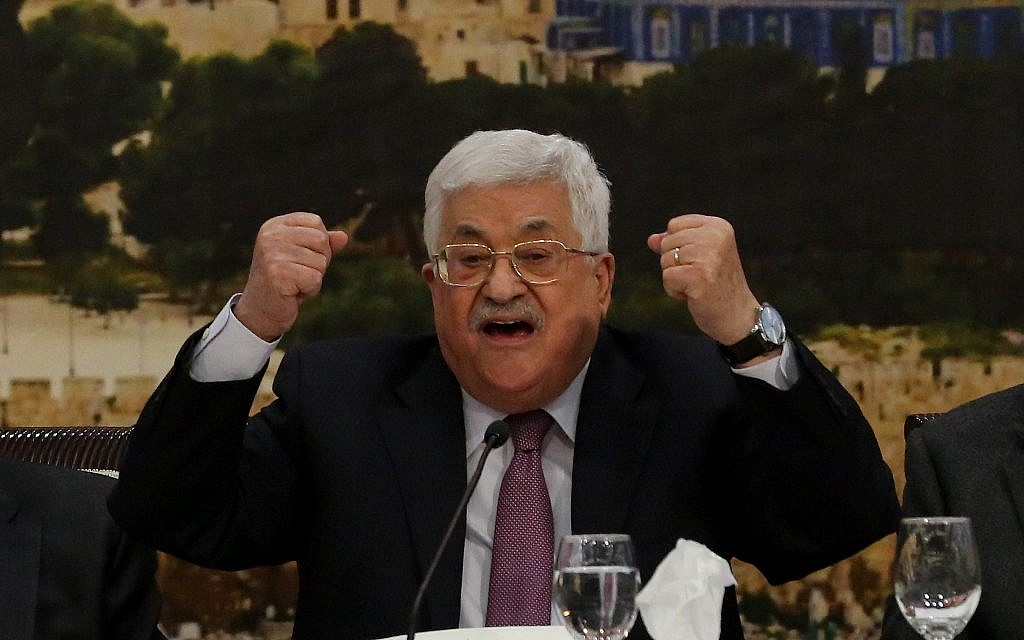The unwanted two-state solution
Why do the United States and Israel keep offering Palestinians something they consistently and violently oppose?
By Joel Margolis
JNS
Sep 12, 2024
Mahmoud Abbas has vowed time and time again that there will be only one state from the river to the sea, a Palestinian state with out any Jews
Recent remarks by U.S. Vice President Kamala Harris addressed the current war between Israel and Hamas in the Gaza Strip. She pledged that if elected president, she would continue a U.S. policy that encourages Israelis and Palestinians to negotiate a “two-state solution.” That solution envisions two states for two peoples, living side by side in peace and security, with Jerusalem as their shared capital.
Tragically, the Palestinians have never embraced this ideal. They have consistently rejected two-state offers from the United States, Israel and other parties. Starting long before the 1948 creation of modern-day Israel, they tried all possible means—military, economic, legal and political—to rid the area of Jews. They declined two-state opportunities in 1919, 1937, 1947, 1967, 1978, 2000, 2001, 2003, 2008, 2013 and 2020. Through that period, their motivating ideology nurtured a strain of militant Islam.
The militant tradition is illustrated by the current war. Hamas’s charter promotes the murder of Jews. The invasion of Oct. 7 was Hamas’s fifth war on Israel in the past 16 years. Participants in the genocidal slaughter included members of Islamic terrorist groups in both Gaza and the West Bank. They titled the massacre the “Al-Aqsa flood,” a tribute to the highly-revered mosque in Jerusalem. The killing began on a Jewish holiday. They justified the butchery as a “jihad” composed of “martyrdom operations” against the “Zionist entity” to recover “Muslim Land.” The aggression followed their interpretation of Sharia law, which purportedly allows them to exploit their own people as human shields and target Israeli civilians with kidnapping, sexual torture, burning, beheading and bodily mutilation. (See, in contrast, the statement issued by the Global Imams Council on Sept. 1.)
A July 2024 opinion poll by the Palestinian Center for Policy and Survey Research found that 65% of Palestinians do not want a two-state solution; 75% approve of the Oct. 7 attack; and 63% welcome further “armed struggle.” In short, the two-state theory naively offers sovereign coexistence to people who, by all appearances, crave sovereign exclusivity.
Attempts to frame Palestinian nationalism as a liberation movement never fit the facts. There was never a state called “Palestine.” Until World War I, Arabs in and around present-day Israel were subjects of the Ottoman Empire, not any Arab state. Their early-20th-century offspring denounced “Palestine” as a European invention for Jews. The mid-20th-century Arabs in Israel became Israeli citizens, while Arabs in eastern Jerusalem and the West Bank became Jordanian citizens and Gazan Arabs remained non-citizens under Egyptian occupation. Only after Israel’s creation did these diverse communities allege the existence of a common pre-existing Palestinian state.
The geographic scope of the supposed Palestine has also morphed over time. Before World War I, the eastern Mediterranean region consisted of Ottoman colonies. In the 1920s, when the League of Nations allocated the “mandatory” districts that prefigured present-day Lebanon, Syria, Iraq, Jordan and Israel, the Arabs developed the Arab districts into Arab states but still attacked Mandatory Palestine, the district earmarked for the Jewish state. They claimed pre-state Israel was southern Syria. In the early 1960s, they associated Israeli territory with the Arab Nation, a tenuous pan-Arab political alliance headed by Egypt. Their manifesto claimed ownership of Israel but expressly excluded Gaza, eastern Jerusalem and the West Bank because those domains were already controlled by Arab states. Today, Palestinians reference Israel, Gaza and the West Bank as Palestine or Palestinian land, labels that erase Israel.
The only legally cognizable two-state solution is one Palestinians want to forget. In 1922, the League of Nations severed 77% of Mandatory Palestine to create Jordan. Nevertheless, the Arabs kept skirmishing for the remaining 23%—namely, Israel, Gaza and the West Bank. Most Jordanians are Palestinians. Therefore, it is argued, Palestinians already have a state in Jordan.
To be sure, a two-state solution was the contemplated end product of the only peace agreements signed by the Palestinians with Israel—the Oslo Accords of the 1990s. In those agreements, Israel essentially awarded the Palestinians temporary control over the Palestinian population centers of the West Bank and Gaza in exchange for a halt to terrorism as a first step toward a permanent arrangement. But the Palestinians breached the deal. In fact, they murdered more Israelis in the 10 years after the start of the accords than in the 10 years before.
The world community should pressure the Palestinians to abandon their antisemitic warpath and comply with the Oslo Accords. There are sound arguments for a two-state solution, and, some would argue, compelling reasons for Israel to avoid actions that foreclose that possibility. But a credible demonstration that the Palestinians actually desire that result is necessary before it can be realistically pursued.

No comments:
Post a Comment